ISSN ONLINE(2319-8753)PRINT(2347-6710)
ISSN ONLINE(2319-8753)PRINT(2347-6710)
Deepika Bansal1, Dr. Renu Bagoria2, Vinod Sharma3
|
| Related article at Pubmed, Scholar Google |
Visit for more related articles at International Journal of Innovative Research in Science, Engineering and Technology
Image enhancement has significance in image processing. This technique is used as a preprocessing step in speech recognition, texture synthesis, Computer graphics, intelligent transportation systems, Digital camera images etc. To enhance the image we have to enhance the contrast, removal of noise and motion blur if present. We improve contrast by histogram equalization and adaptive histogram. These are the method that gives good result to improve contrast. We can remove the noise by median filter, wiener filter and we can remove noise by our filter also that we coded in MATLAB. After that we can remove motion blur also from the same image by using total variation method. So this paper presents a GUI in which we have all the function for the image enhancement for the same image of input.
Keywords |
| Linear Filter, Image enhancement, noise removal, Histogram equalization, Contrast enhancement, image processing. |
INTRODUCTION |
| Digital image processing technology is used by planetary scientists to enhance images of mars, Venus or other planets. One of part of the image processing is the image enhancement. Image Enhancement is the technique to improve the interpretability or perception of information in images for human viewers [2]. It is to improve the image quality so that the resultant image is better than the original image for a specific application. The main purpose of image enhancement is to bring out detail that is hidden in an image or to increase contrast in a low contrast image. Image enhancement can be done by improving contrast and removing noise from the image or if image is blurred then we remove blurring also. contrast enhancement technique is used as a preprocessing step in speech recognition,texture synthesis, Comparison of image processing software, , Intelligent transportation systems, Computer graphics ,Digitizing, Multidimensional systems, In Military, In Medical, In Industrial production and many other applications.[1]In five senses – hearing, smell, sight,taste and touch– which humans use to comprehend their environment, sight is the most powerful. In fact, more than 99% of the activity of the human brain is involved in processing images from the visual pallium. So the image enhancement is required. In addition HE, AHE will also make the medium brightness toward the middle gray level of an image disregarding of the input image, and introduce objectionable artifacts and affected contrast effects. This makes the visual quality of processed imagery inadequate image histograms resembles each other as much as possible. [4]In image acquisition process if noise is present in the image that will be an error. In result we have an image that does not give the true intensity of the image pixels.[4] The process of removing noise from a signal or from an image is called noise reduction. Conceptually, the signal processing as same as the noise reduction technique. However, the knowledge of input signal is required by which we can find the expected output that is depend on the type of signal. Firstly image captured by the sensor then image goes under different types of smoothing filters after that we have the output or resultant image. The main problem of image processing is to reduce noise from a digital color images. There are many sources of noise by that it can be added to an image depend only on image that how will it created. A picture is a set of pixels, each contain an average value of light caught in time of exposure - the time frame. When the subject does not move during the time frame (and is in focus), it will appear frozen in the image and we will get sharper edges. Blur occur when a cell (or pixel) catch light from more than one point at the scene.[5] Blur is very common in pictures. When taking picture with blur, a lot of information lost. Detecting blur in images and then reconstruct the blurred areas could restore some of this information. This is the motivation for detecting motion blur in images. Out of focus images created when the subject captured is not in the depth of field of the lance making the image or part of it blurred. Blur can also appears when the shutter is open causing each pixel capture light from more the one direction. Motion blur is usually created in an image when the time of exposure is long relatively to the velocity of movement. Our goal is to identify motion in blurred pictures. We will try to identify motion in the scene which was caused by relative motion between the camera and the entire scene, and also a local blur that appears in the image caused by motion of one or more objects in the scene or motion of the background (relative to the camera). Meaning, we could expect part of the scene to be sharp. The resultant image will be without noise and motion blur with enhanced contrast. [9] |
IMAGE ENHANCEMENT |
| We can categorize image enhancement mainly in this two categories.q |
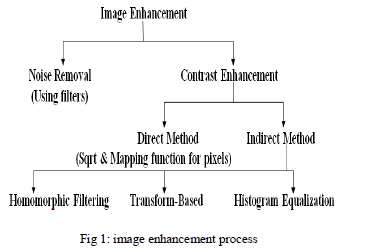 |
| Enhancement of an image can be implemented by using different operations of sharpening, brightness increment, noise removal or blurring. Unfortunately, there is no general theory for determining what ‘good’ image enhancement, when it comes to human sensing. [5] |
| a) Noise Removal |
| It is an operation to remove undesirable details from an image. This detail gets attached to an image while clicking image or acquisition process. Noise may be capturing device inability, due to environment particles, lack of experience of machine/computer operator or some other reason. [5] |
| b) Contrast enhancement |
| Contrast is related to the color and brightnessterms. It is basically improving the interpretability,sensing of information in images for human viewers and providing `better' input for other automated image processing techniques. [6] |
HISTOGRAM EQUALIZATION |
| The objective of this method is to make an image apparentlyaccepted for a specific application. One of the most appropriate contrast enhancement methods is histogram equalization (HE). HE mechanism is to transform the gray levels of an image to a uniform histogram based on the probability of occurring gray levels in an input image. In general, by HE method it will flatten out the probability distribution of an image and increase its dynamical range. However, the strength of HE depends on the contrast of the original image. The lower the contrast, the more the strength is. Since its simplicity make it easy to implement. It is usually applied in many areas including texture synthesis, medical image processing and speech recognition. [3] |
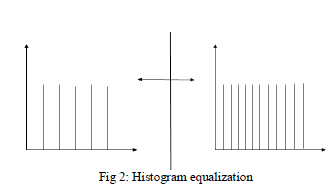 |
| I. Advantage: |
| An advantage of this method is that it is a fairly straightforward technique and an invertible operator. So in theory, if the histogram equalization function is known then the original histogram can be recovered. [2] |
| II. Disadvantage: |
| A disadvantage of the method is that it is general method. It will increase the contrast of background noise, while decreasing the usable signal. |
FILTERS ROLE IN DENOISING |
| Filter is used to remove the noise from the images. Noise is present in images in the form of: |
| A. White and black spots on image |
| B. In ultrasound images with black intensity |
| There are different types of filters: average filter, mean and median filter etc. Thefilter performs spatial processing to determine which pixels in an image have been affected by noise. It classifies pixels as noise by comparing each pixel in the image to its surrounding neighborpixels [7]. The size of the neighborhood is adjustable, as well as the threshold for the comparison. A pixel that is different from a majority of its neighbors, as well as being not structurally aligned with those pixels to which it is similar, is designated as impulse noise. These noisy pixels are then replaced by the median value of the pixels in the neighborhood that have passed the noise detection test. |
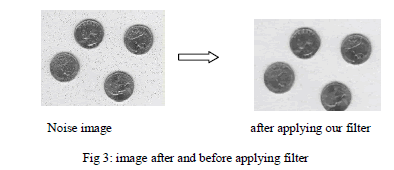 |
MOTION BLURRING |
| Within an exposure period, the movements of the camera or the objects produce motion blurred images, as the luminance changes are integrated over time and the sharpness is smeared. On the other hand, a motion blurred image retains information about motion that parameterizes the blur. Thus it gives us clues to recover motion from this single image. A motion blur is characterized by its point spread function (PSF) whose parameters are closely related to the motion. The simplest motion blur is the space-invariant linear motion blur, which has been studied extensively. In practice, however, as motion can be quite complex, motion blurs can be much more complicated than this simple case Restoration of blurred images is a vital problem especially in tracking and identification of criminals. The available image can be used to identify a human face or a moving vehicle’s number plate taken in hit and run situation or in a bomb blast site. To restore a blurred image successfully, blurring function needs to be estimated accurately. the reasons for these imperfections can be Relative motion between camera and the subject being captured During the exposure time of the camera, this type of motion causes the pixels being spread over a distance in the direction of the motion. It can be said that the image gets integrated over time during the exposure thus causing a single pixel recorded from each point of the scene contributing to several different pixels in the real image. This degradation of image can be termed as motion blur. For the purpose of restoration, it is often assumed that a motion-blurred image g can be modeled as |
| g=f*h+n, (1) |
| Where f, h, and IZ are the original scene, linear shift-invariant point spread function (PSF), and noise, respectively. When the PSF is known, many techniques are available for estimating f from g. However, for a real-world motionblurred image, the PSF is generally unknown. It is then necessary to assume a PSF to carry out the restoration, and methods have been developed for estimating PSFs from the blurred images.So in this research we use the Total variation constraint least square method using alternating direction method of multiplier (ADMM) algorithm. In which we use the deblurring filter. |
RESULT |
| We created a GUI using MATLAB. In which we have functions for loading the image after that we can apply different functions on the same image that functions are: |
| A. We can adjusting the contrast and we can have histogram of output image also |
| B. Histogram equalization and its image histogram |
| C. Adaptive histogram equalization and image histogram |
| D. After that we can remove noise using median filter |
| E. Remove noise using wiener filter |
| F. Remove noise using newly created filter |
| G. We can also remove motion blurring by using total variation method |
| We can apply whole operation on the same image or we can change image by resetting the image. |
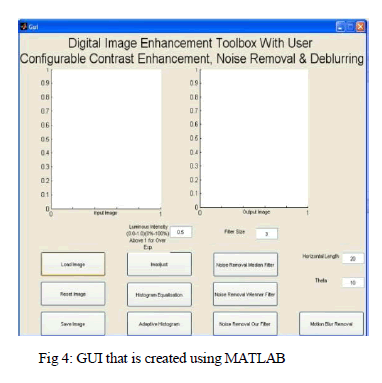 |
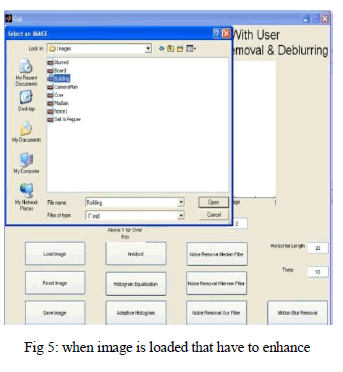 |
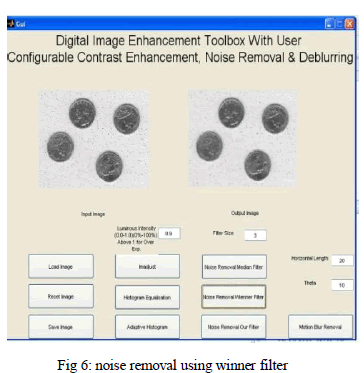 |
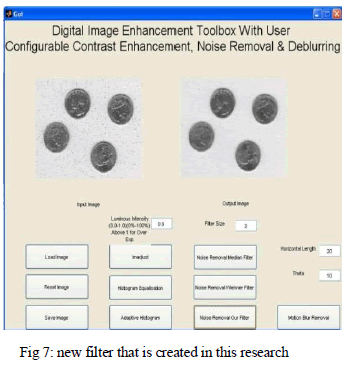 |
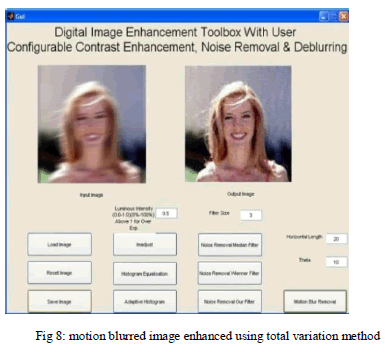 |
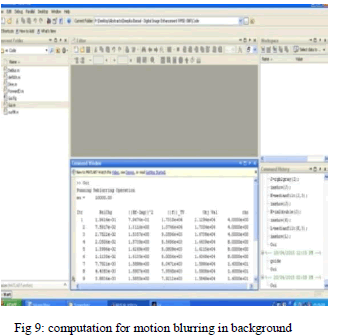 |
CONCLUSION |
| The new GUI is created in which Image enhancement is done by improving contrast or by removing noise and motion blur. For improving contrast we can use different type of histogram equalization techniques that are HE, AHE etc. By the comparison or study we get to know the result by histogram equalization is much better than other techniques that are present for contrast improvement.so here, histogram equalization and adaptive histogram equalization is successfully applied. After that removal of noise by median filter and wiener filter is done. Here we made our filter that also applied to the image. Results are shown. The motion blurring if present on the image can also be removed by this GUI. GUI has buttons for all the operations. |
References |
|